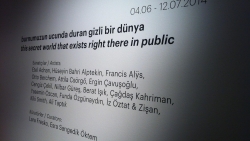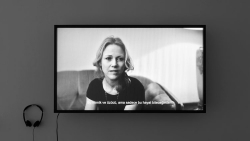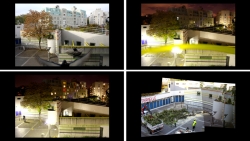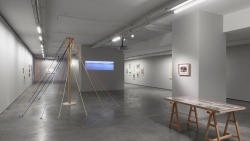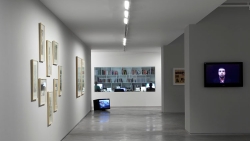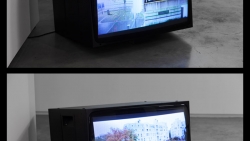This secret world that exists right there in public
Artists: Etel Adnan • Hüseyin Bahri Alptekin • Francis Alÿs • Otto Berchem • Attila Csörgo • Ergin Çavusoglu • Cengiz Çekil • Nilbar Güres • Berat Isik • Çagdas Kahriman • Yasemin Özcan • Funda Özgünaydin • Iz Öztat & Zisan • Kiki Smith • Ali Taptik
Curators: Lara Fresko, Esra Sarigedik Öktem
June 4 — July 19, 2014
Rampa’s first group exhibition this secret world that exists right there in public, co-curated by Lara Fresko and Esra Sarigedik Öktem brings together the works of 16 artists including Etel Adnan, Hüseyin Bahri Alptekin, Francis Alÿs, Otto Berchem, Attilla Csörgo, Ergin Çavusoglu, Cengiz Çekil, Nilbar Güres, Berat Isik, Çagdas Kahriman, Yasemin Özcan, Funda Özgünaydin, Iz Öztat & Zisan, Kiki Smith, and Ali Taptik.
The exhibition takes its inception and title from a scene in Noah Baumbach’s 2012 film Frances Ha, in which Frances, talking to strangers in semi drunken fervor, points out a fleeting moment when the transformative potential of love as well as the miracle of unmediated communication is rendered possible and visible. Focusing on the potentials of interpersonal relations and social movements to envision alternative worlds, the exhibition brings together works from different histories and geographies.
Three central works explore the many facets of travel, crossing borders, creating channels of communication, instituting solidarity, storytelling and imagining utopian and dystopian alternatives through a cartographic approach. In The Loop (1997) Francis Alÿs takes an unexpected route to go from Tijuana to San Diego without crossing the Mexico/United States border. In a similar vein, Hüseyin Bahri Alptekin’s diptych piece Black Sea Map / Kéraban Lé Têtu (1999) follows Jules Verne’s stubborn tobacco merchant in a journey all the way around the Black Sea regions in order to get to Istanbul’s Asian coast without crossing the Bosphorus. A remnant of what became an unfinished project of the artist to forge networks of communication among the contemporary art scenes of Turkey with its northern neighbors is not only a vision of alternative routes but also a cultural project of solidarity formation. Iz Öztat & Zisan’s collaboration consists of a drawing of the Island of Paradise/Possessed (1915-1917) by a fin de siecle avant-garde artist Zisan, that takes the form of three letters that spell both Paradise and Possessed in Ottoman script. Within their cross generational relationship, Zisan’s departure point for the map draws Iz Öztat into a journey through the absent Island of Adakale on the Danube, which materializes in a publication and a video work titled Constituting an Island (2014).
A preoccupation with space and place are treated formally in two of Etel Adnan’s abstract paintings, which evoke landscapes, Untitled (Beirut) #077 and Untitled (Beirut) #132, and verbally in Ergin Çavusoglu’s Place Series (2008). Attilla Csörgo’s sketches, Squaring the Circle (2012) are geometric studies evocative of the great Architect Sinan’s fascination with placing a circle on top of a square in building a space of community as well as divine communication.
Otto Berchem’s tent-like structure invokes a traditional ritual of community with May Pole (2013), a sculpture piece on which he projects the color abstractions he blocks out from protest signs on black and white photographs of social mobilization across the world through recent history. Cengiz Çekil takes the one of the most popular media of the 20th century, and strips it to its bare imagery in his newspaper collage from the series Unwritten (1977), opening up alternative readings through images as well as questioning the very credibility of the image itself. Yasemin Özcan’s Soap Opera Synopses, an installation dated 1997, is reconstructed in the back of the gallery space, standing in as a relic from our near history, with a sound that haunts our psyche. Özcan’s intervention into the text, which reflects the socio-political agenda of its time, gives a wonderous contextualization, and a glimpse into the machinations of repetition and change.
The exhibition explores the momentary encounters Frances imagines, in geography, history, and popular media as well as in quotidian and fantastic imaginaries of nature. Ali Taptik’s photographs depicting the urban flora arise from his practice of walking and documenting the minute details of urban landscape. His survey of a variety of frail potted plants scattered throughout the city resonates with Çagdas Kahriman’s lament for an urban tree in Fenêtre sur cour. Berat Isik’s video duo, Butterfly Effect (2012), and Falling (2013) were produced as two separate pieces. Shown in this exhibition together, the duo explores the transformative potential of breath as the source of human voice. This potential is explored in the breath that is held and let go in Butterfly Effect and the gas filled balloons that are left to roam the skies.
Kiki Smith’s animal drawings from the series Everywhere (2010) explore a world which is accessible only through the perception of animals, and remain closed to human beings. Funda Özgünaydin’s human-animal collages depict the hybridization of the species, a strategy which aspires to glimpse into the perceptive range of our co-habitors. Nilbar Güres’s Spider Woman; Mother (2006), a barely visible piece that hanging uncannily from a corner harbors a quiet and unexpected strength, opening up a world not visible to those outside her web.
Bringing together works that twist, open up or change our perception, the exhibition aims to create a space where the secret world that exists right there in public appears as a possibility. The exhibition hails the social movements that will surely leave a mark on the 10’s of this century by taking a fresh look at history, geography, architecture, and nature.
Crédits photo : Chroma
